Chapter 23
Exploring 3D Mesh and Surface Modeling
Autodesk® AutoCAD® software has always offered tools that allow users to construct fairly complex 3D models. With the introduction of the latest solid modeling tools, you can even model some very organic forms. But some forms require a type of modeling known as mesh modeling. Mesh modeling lets you create smooth, curved volumes by manipulating faces that make up an object’s surface.
With mesh modeling, you can quickly create curved shapes that are difficult or even impossible to create by other means. With AutoCAD you can also convert a mesh model into a 3D solid so that you can perform Boolean operations.
In addition, AutoCAD has a set of 3D surface modeling tools that extend its ability to produce and edit curved, organic forms. In this chapter, you’ll get a chance to explore many of the current features of mesh modeling through a series of exercises, and you’ll be introduced to the surface modeling tools. You’ll also learn how you can convert a mesh or 3D surface into a solid. You’ll start by creating a simple shape as an introduction, and then you’ll move on to a more complex form.
In this chapter, you will learn to
- Create a simple 3D mesh
- Edit faces and edges
- Create mesh surfaces
- Convert meshes to solids
- Understand 3D surfaces
- Edit 3D surfaces
Creating a Simple 3D Mesh
As an introduction to the mesh modeling features in AutoCAD, you’ll draw a simple box and then smooth the box. This first exercise will show you some of the basic mesh modeling tools and what types of control you can exert on a model.
First, you’ll make sure you are in the 3D Modeling workspace and that you have a blank drawing set up for the mesh. Follow these steps:
- Click the New tool on the Quick Access toolbar.

- In the Select Template dialog box, select the
acad3D.dwttemplate and then click Open. - Click the Workspace pop-up list in the status bar and select 3D Modeling, as shown in Figure 23-1.
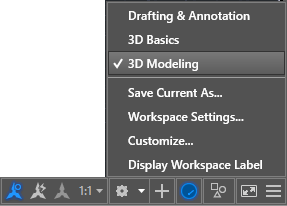
Figure 23-1: The 3D Modeling workspace
- Choose the Shaded With Edges visual style from the Visual Styles drop-down list on the drawing screen. This will give you a close approximation of the appearance of the meshes you’ll see in the illustrations in this book.
Creating a Mesh Primitive
Meshes are similar to solids in that they start from a primitive. You may recall that 3D solid primitives are predetermined shapes from which you can form more complex shapes. The mesh primitives are similar to the 3D solid primitives you learned about in Chapter 20, “Creating 3D Drawings,” and Chapter 22, “Editing and Visualizing 3D Solids.” You can see the different mesh primitives that are available by clicking the Mesh flyout in the Primitives panel (see Figure 23-2).

Figure 23-2: The primitives in the Mesh flyout of the Primitives panel
In the next exercise, you’ll use the Mesh Box primitive to start your cushion:
- In the Mesh tab’s Primitives panel, click the Mesh Box tool, or type Mesh↵B↵.

- At the
Specify first corner or [Center]:prompt, enter 0,0↵ to start the mesh at the drawing origin. - You’ll want a mesh that is 21 units in the x-axis by 32 units in the y-axis, so at the
Specify other corner or [Cube/Length]:prompt, enter 21,32↵. - At the
Specify height or [2Point]:prompt, place your cursor anywhere above the base of the mesh and enter 4↵ for a 4 unit height. You now have a basic shape for your mesh (see Figure 23-3).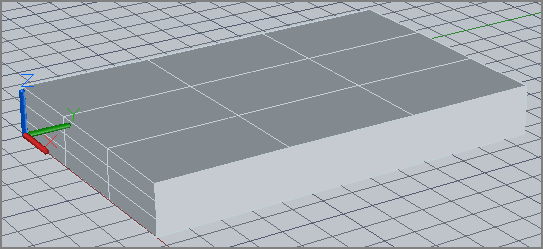
Figure 23-3: The Mesh Box primitive
You’ve just created a mesh box, but you have several other mesh primitives at your disposal. If you click the Mesh flyout on the Primitives panel, you’ll see the cone, cylinder, pyramid, sphere, wedge, and torus primitives. When creating your model, consider which of these primitives will best suit your needs.
Understanding the Parts of a Mesh
Before you go any further, you’ll want to understand the structure of a mesh. Notice that each side is divided into nine panels, or faces, as they are called in AutoCAD. You can edit these faces to change the shape and contour of your mesh. You can control the number of faces of a mesh through an options dialog box that you’ll learn about later.
Figure 23-4 shows the names of the different parts of a simple mesh: the vertex, the edge, and the face. These three parts are called subobjects of the mesh, and you can move their position in the mesh to modify a mesh’s shape.
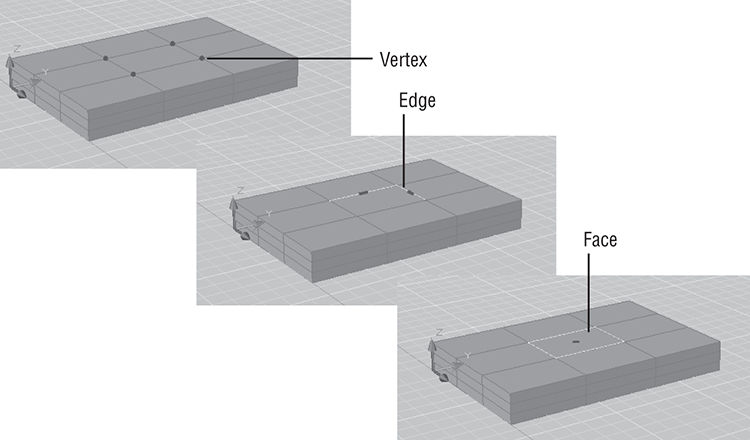
Figure 23-4: The subobjects of a mesh

To help you select different subobjects on a mesh, the Selection panel offers the Filter flyout, which shows the No Filter tool by default. You’ll get to use this flyout in many of the exercises in this chapter.
Smoothing a Mesh
One of the main features of a mesh is its ability to become a smooth, curved object. Right now your cushion has sharp edges, but you can round the corners using the Smooth tools.
Try modifying the mesh to smooth its corners:
- Click the rectangular mesh to select it.
- Click the Smooth More tool in the Mesh panel or the Smooth panel, or type Meshsmoothmore↵. The edges of the mesh become faceted and smoother in appearance.

- Click Smooth More again. The mesh becomes smoother still (see Figure 23-5).
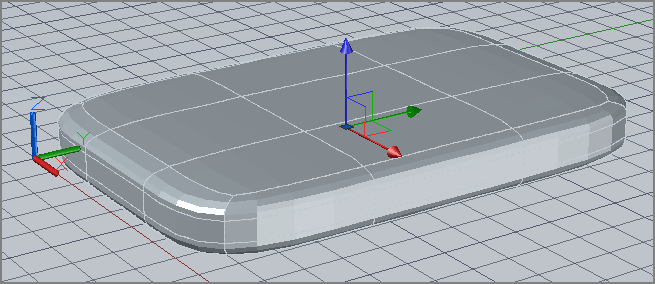
Figure 23-5: The mesh after applying the Smooth More tool twice
- Now click Smooth Less, or type Meshsmoothless↵. The mesh becomes less smooth.

- Press Esc to clear the selection.
As you can see from this exercise, you can smooth a mesh using the Smooth More tool. The more times you apply it to a mesh, the smoother your mesh becomes. The number of faces of the mesh determines how the Smooth More tool affects the mesh. The fewer the faces, the broader the application of smoothness.
When you apply the Smooth More tool to a mesh, the faces of the mesh become faceted. This simulates the smooth appearance. If you look closely at a mesh that has only one or two levels of smoothing applied, you can see the facets.
Editing Faces and Edges
The shape you created earlier demonstrates one of the main features of meshes. In this section, you’ll create a model of a surfboard to see how you can push and pull the subobjects of a mesh to create a form.
You’ll start with the same form, a box shape, but this time you’ll modify some of the parameters that define the box’s structure. You can control the number of faces that a mesh primitive will have before it is created. The following exercise introduces you to the tools and methods used to edit meshes.
Start by creating a new drawing and setting up the parameters for the mesh:
- Click the New tool in the Quick Access toolbar, select

acad3D.dwt, and then click Open. - In the Mesh tab, click the Mesh Primitives Options tool in the Primitives panel title bar. The Mesh Primitive Options dialog box appears (see Figure 23-6).

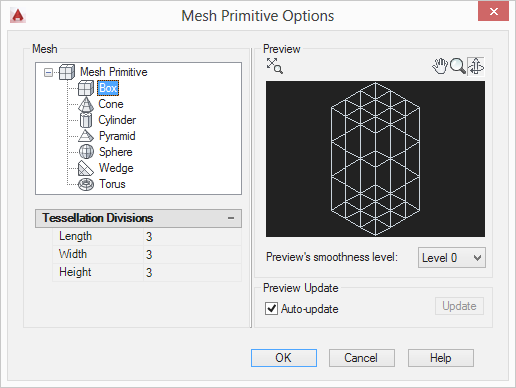
Figure 23-6: The Mesh Primitive Options dialog box
- In the Tessellation Divisions rollout in the Mesh group, change the Length and Width values to 4 and the Height value to 1. Click OK when you’ve finished making the changes.
- In the Home tab’s View panel, choose the Shaded With Edges visual style from the Visual Styles drop-down list.
The parameters you change alter the number of faces on mesh primitives that you create, including the box primitive that you will create in the next exercise. You’ll see the results after following the next set of steps:
- Click the Mesh Box tool found on the Mesh tab in the Primitives panel.
- At the
Specify first corner or [Center]:prompt, type 0,0↵ to start the corner at the origin of the drawing. - At the
Specify other corner or [Cube/Length]:prompt, enter 50,30↵ to create a 50×30 unit base for the box. - At the
Specify height or [2Point]prompt, point the cursor in the positive Z direction and then enter 3.5↵ for a 3.5 unit thickness. - Center the box in your view. Your model should look similar to Figure 23-7.

Figure 23-7: The mesh box
- Click the box to select it. Then, in the Mesh panel, click the Smooth More tool twice. The edges of the mesh become more rounded.
Stretching Faces
You now have the basis for the surfboard, though it might seem like an odd shape for a surfboard. Next you’ll start to form the surfboard by manipulating the faces and edges of the mesh. Start by pulling two sides of the mesh to give it a shape more like a surfboard:
- Use the ViewCube and Pan tools to adjust your view so that it looks similar to Figure 23-8. This view will allow you to easily select and “pull” some of the faces that will become the front and back of the surfboard.
- In the Selection panel, select Face from the Filter flyout (see Figure 23-9).

Figure 23-8: Hold down the Ctrl key, and place a crossing selection window as shown here.
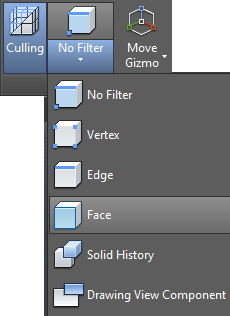
Figure 23-9: Select the Face filter.
- Hold down the Ctrl key, and then click and drag a crossing selection window over the middle faces at the front edge of the box, as shown in Figure 23-8. The faces are highlighted, and you see the XYZ gizmo.
- Place your cursor on the red x-axis of the gizmo.
- When the red axis vector line appears, click and drag the gizmo downward in a positive X direction. The mesh begins to elongate.
- When your mesh looks similar to Figure 23-10, release your mouse button.
- Press Esc to remove the faces from the current selection.

Figure 23-10: Click and drag the gizmo when you see the red axis vector.
The portion of the mesh you “pull” out will become the front. Next do the same for the back of the surfboard:
- Use the Pan tool to adjust your view so that it looks similar to Figure 23-11. This view will allow you to easily select and “pull” some of the faces that will become the back of the surfboard.
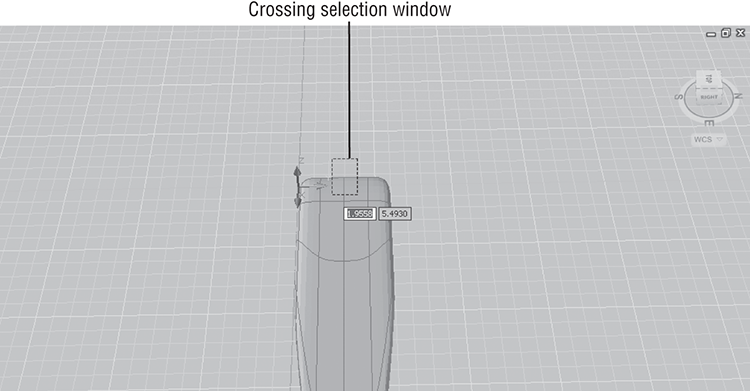
Figure 23-11: Place a crossing selection window as shown here. Be sure to press and hold the Ctrl key in order to make the proper selection.
- Click on the box mesh to expose its mesh lines again.
- Hold down the Ctrl key, and then place a crossing selection window over the middle faces at the back edge of the box, as shown in Figure 23-11. The faces are highlighted, and you see the XYZ gizmo.
- Place your cursor on the red x-axis of the gizmo, and when the red axis vector line appears, click and drag the gizmo upward in a negative X direction.
- When your mesh looks similar to Figure 23-12, release your mouse button.

Figure 23-12: Adjust the mesh to look similar to this one.
- Press Esc to remove the faces from the current selection.
- Click the Home tool on the ViewCube to get a better view of your mesh at this point (see Figure 23-13).


Figure 23-13: The mesh so far
Moving an Edge
The surfboard needs a sharper point at the front. Instead of moving the faces as you’ve already done, you can move an edge to give the front a more pointed shape. The next set of steps will show you how to do this:
- Using the ViewCube, adjust your view so that you have a close-up of the front tip of the surfboard, as shown in Figure 23-14.
- In the Selection panel, select Edge from the Filter flyout.

- Hover over the front edge until you see the edge line, and then click the edge, as shown in Figure 23-14. The Move gizmo appears.

Figure 23-14: Click the front-center edge shown here.
- Hover over the x-axis of the gizmo, and when the red vector line appears, click and drag the x-axis downward along the positive X direction.
- When it looks similar to Figure 23-15, release the mouse button.

Figure 23-15: Pull the front edge so that the mesh looks similar to this image.
Next, give the front of the mesh a slight curve by adjusting the z-axis of the front edge:
- Hover over the z-axis of the gizmo, and when the blue axis vector line appears, click and drag the z-axis downward in the negative Z direction.
- When it looks similar to Figure 23-16, release the mouse button.
- Press the Esc key twice to clear your edge selection.
- Click the Home tool in the ViewCube to return to the home view.
We asked you to adjust the edge downward because you’ll want to have a bottom view of your surfboard. This will enable you to add fins to the board without having to flip the mesh over.
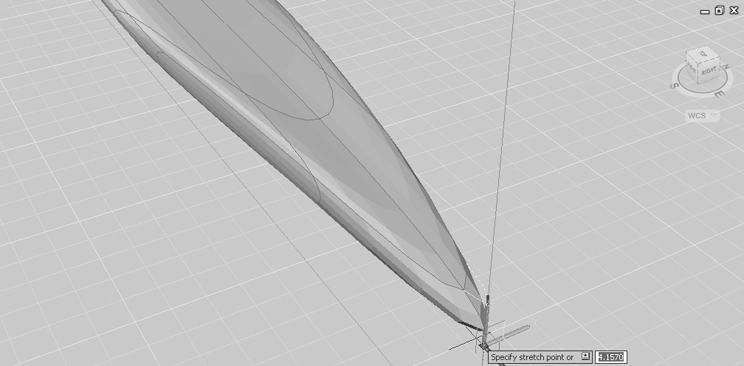
Figure 23-16: Move the front edge downward in the z-axis.
Adding More Faces
The surfboard is still missing some fins. You could model some fins as separate meshes and then later join them to the surfboard. You can also use the Refine Mesh tool to add more edges and then use those edges as the basis for your fins. The following exercise will show how this is done:
- Adjust your view so that it looks similar to the top image in Figure 23-17.
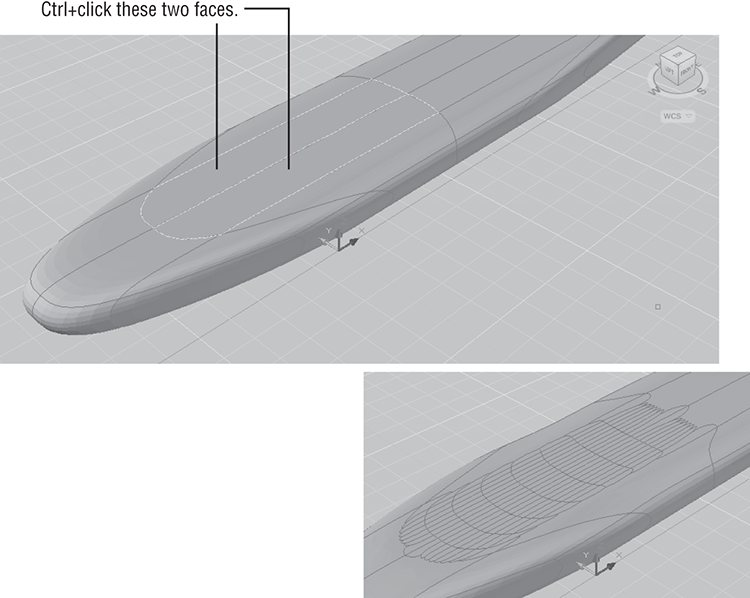
Figure 23-17: Select the faces to refine.
- From the View tab’s Visual Styles panel, open the Visual Styles drop-down list and select Shaded With Edges. This will allow you to see the edge lines of the mesh as you work through the following steps.
- Click the mesh, and then from the Mesh tab’s Mesh panel, click Smooth More. This will increase the number of edges that are generated in the next step.
- Press the Esc key to clear your selection.
- On the Selection panel, select Face from the Filter flyout.

- Ctrl+click the two faces shown in the top image of Figure 23-17.
- Click the Refine Mesh tool on the Mesh panel, or type Meshrefine↵. The selected faces will be subdivided into smaller faces and edges, as shown in the bottom image of Figure 23-17.

The next step in creating the fins is to edit some of the newly created edges:
- Zoom into the surfboard so that your view looks similar to Figure 23-18.

Figure 23-18: Select the edges for the fins.
- On the Selection panel, select Edge from the Filter flyout.

- Click the edges shown in Figure 23-18.
- Hover over the z-axis on the gizmo so that the axis vector appears, and then click and drag the z-axis upward in the positive Z direction. If you run out of room at the top of the window, you can move the z-axis as far as you can with one click and drag and then repeat the move.
- Adjust the edges so that they look similar to those in Figure 23-19, and then release the mouse button.
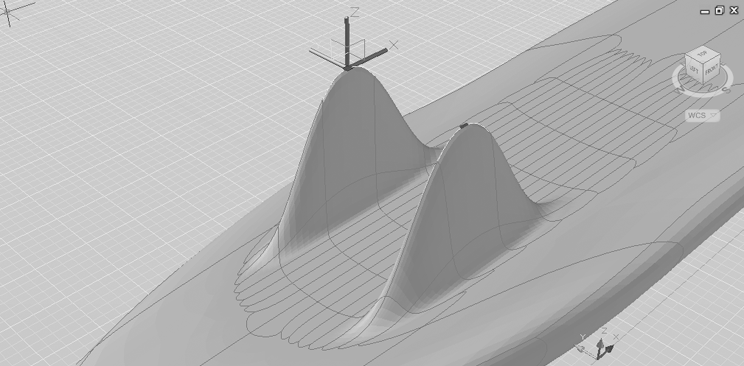
Figure 23-19: Adjust the edges to create the fins.
- Adjust the x-axis of the gizmo toward the back of the surfboard so that the fins look similar to Figure 23-20.

Figure 23-20: Adjust the fins toward the back of the surfboard.
- Press the Esc key to clear your selection of mesh edges.
Rotating an Edge
The fins aren’t quite the right shape. They are a bit too broad at the base. The next exercise shows you how to rotate an edge to adjust the shape of the fins further:
- With the Edge subobject filter still selected, click the back edge of the fins, as shown in Figure 23-21.
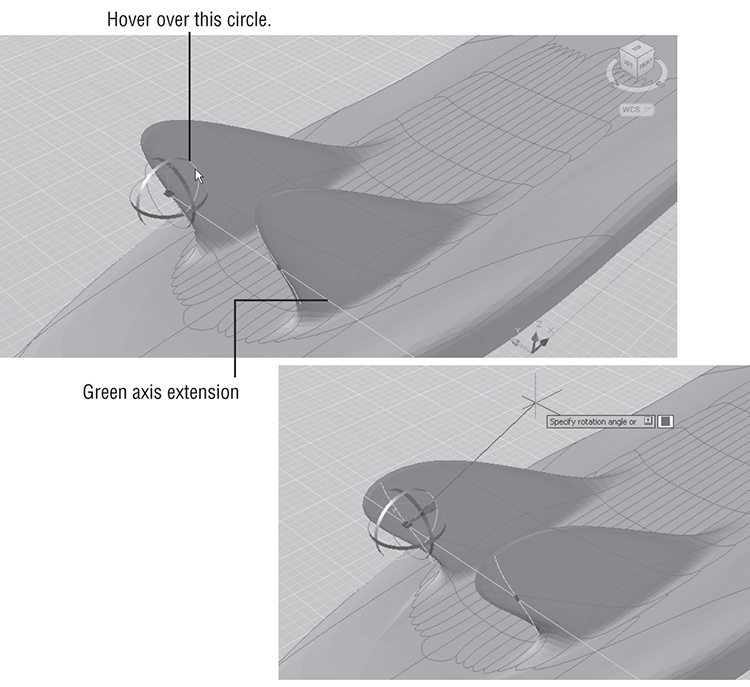
Figure 23-21: Click and drag the green circle on the Rotate gizmo.
- In the Selection panel, select the Rotate Gizmo tool from the Gizmo flyout (see Figure 23-22).
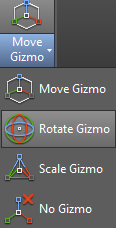
Figure 23-22: Select the Rotate Gizmo tool.
- Hover over the green circle of the Rotate gizmo in the location shown in the top panel of Figure 23-21 until you see the green axis vector, and then click and drag to rotate the edge. Adjust the rotation of the edge so that the fins look similar to those in the lower panel of Figure 23-21, and then release the mouse button.
- Press the Esc key to clear your selection.
- Use the Home tool on the ViewCube to get an overall view of the surfboard (see Figure 23-23).

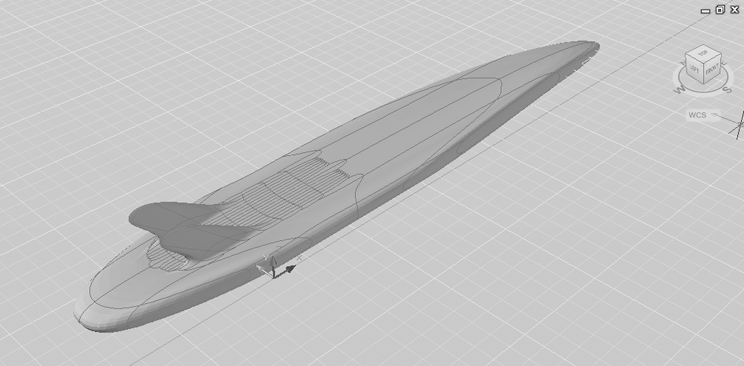
Figure 23-23: The finished surfboard
In this exercise, you switched from the Move gizmo to the Rotate gizmo. You can also use the Scale gizmo to scale a face or edge.
This may not be the most accurate rendition of a surfboard (our apologies if you are a surfer), but the general shape of the surfboard has given you a chance to explore many of the features of the Mesh toolset.
Adding a Crease
You’ll want to know about one more tool that can help you fine-tune your mesh shapes. The Add Crease tool on the Mesh panel does exactly what it says. It can introduce a crease in your otherwise smooth mesh shape. Add Crease does this in two ways: It can flatten a face or remove the smoothing around an edge.
In the following exercises, you’ll use the surfboard one more time to experiment with the Add Crease tool. First you’ll see how you can add a sharp point to the surfboard:
- Adjust your view of the surfboard so that you can see the front point, as shown in Figure 23-24. Turn off the grid so that you can see the shape clearly.

Figure 23-24: Set up your view. Select the front edge of the surfboard.
- From the Mesh tab’s Selection panel, select the Move Gizmo tool from the Gizmo flyout.

- Click the Add Crease tool in the Mesh panel.

- At the Select Mesh Subobjects to Crease prompt, click the front edge of the surfboard, as shown in Figure 23-24.
- Press ↵. At the
Specify Crease Value [Always] <Always>:prompt, press ↵. - The point of the surfboard becomes much sharper.
You can see from this exercise that the front edge of the surfboard is now quite sharp since it no longer has any smoothness.
Now try applying the Add Crease tool to a face:
- From the Selection panel, select Face from the Filter flyout.

- Click the Add Crease tool and, at the

Select Mesh Subobjects to Crease:prompt, click the two faces on either side of the front edge, as shown in Figure 23-25, and press ↵. - At the
Specify Crease Value [Always] <Always>:prompt, press ↵.The faces are flattened and the point of the surfboard becomes even sharper, as shown in Figure 23-26.
- Save your drawing.
The surfboard is grossly deformed, but you can see how the side faces have now become flat and the edges of the face form a crease. You could use the Add Crease tool to sharpen the edge of the fins. This would also have the effect of making the fins thinner. We didn’t use that example for this exercise because the effects would have been too subtle to see clearly.

Figure 23-25: Click these faces to flatten them.
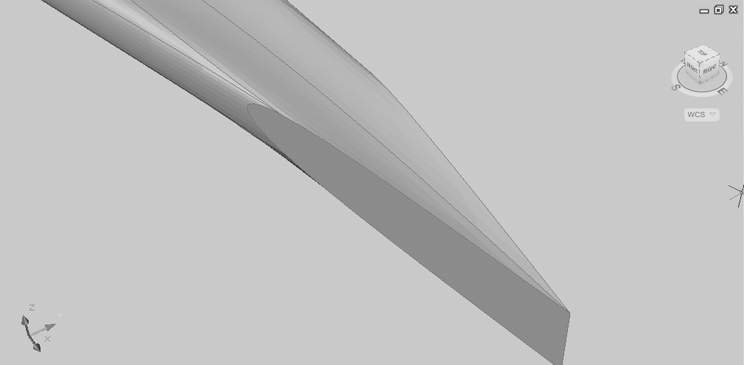
Figure 23-26: The surfboard after applying Add Crease to the side faces on the front
Splitting and Extruding a Mesh Face
Before we move on to the next topic, there are two more tools that can be a great aid in editing your meshes. The Split Face tool does just what its name says. It will split a face into two faces. The Extrude Face tool behaves like the Extrude Face tool you have seen for 3D solids. Both of these tools are a bit tricky to use, so they bear a closer look.
To use the Split Face tool, you first select a mesh face, and then select two points, one on each side of the face. The following exercise shows how it works:
- Open the
SplitMesh.dwgsample file from theChapter 23folder. This file contains a simple mesh box that has been smoothed. - In the Mesh tab’s Mesh Edit panel, click the Split Mesh Face tool, or type Meshsplit↵.

- Make sure the Face filter tool is selected in the Selection panel.

- Click the face shown in the top panel of Figure 23-27.

Figure 23-27: Selecting the points for the split
- Move the cursor to the left edge of the face until you see a knife icon appear next to the cursor.
- Click roughly in the middle of the edge.
- Move the cursor along the right edge of the face. You’ll see some temporary lines, giving you a preview of the location of the split (see Figure 23-27).
- Move the cursor roughly in the middle of the right edge. The face changes temporarily to show you how it will look when it is divided into two faces.
- Click. The shape of the mesh changes to accommodate the new face.
As you can see, Split Face is not a precision tool, but if you don’t like the location of the split, you can move the newly created edge using one of the gizmos.
Next let’s look at the Extrude Face tool. At first, you might think that the Extrude Face tool is redundant since you can use the Move gizmo to move a face in a direction away from the mesh, as you saw in an earlier exercise. Using the Extrude Face tool is different from moving a face because it isolates the movement to the selected face as much as possible. To see how this works, try the following:
- With the Face filter selected in the Selection panel, Ctrl+click the face indicated in Figure 23-28.
- Click and drag the z-axis in the positive direction. When the mesh looks similar to the upper panel of Figure 23-29, click to finish the move. The smoothness of the side is maintained as you pull the face.

Figure 23-28: Select this face.

Figure 23-29: A moved face and an extruded face
- Press the Esc key and click Undo to revert back to the mesh as it was before you moved the face.
- Click the Extrude Face tool in the Mesh Edit panel.
- Click the same face you selected before, and then press ↵.
- Move the cursor along the z-axis in the positive direction. The face is extruded, leaving the faces around it unmoved except for a slight curvature at the base (the lower panel of Figure 23-29).
You can see from this example that the Extrude Face tool confines the deformation of the mesh to only the face you select. Note that you can select multiple faces for the extrusion.
Creating Mesh Surfaces
So far, you’ve been working with mesh volumes, but the Primitives panel of the Mesh tab offers four tools that let you create a variety of surface meshes. These are the revolved, edge, ruled, and tabulated surfaces. If you’re an old hand at working with 3D in AutoCAD software, then these tools should be familiar. They are the latest incarnation of some of the earliest 3D tools offered by AutoCAD, and they work exactly like the old features they replace. But just like the mesh volumes you’ve been working with, the mesh surfaces can be quickly smoothed and their subobjects can be edited using the gizmos you learned about in this and earlier chapters. The following sections give a little more detail about these tools and how they are used. The figures used in these sections are taken directly from the cue cards for each tool.
Revolved Surface
To create a revolved surface, you need a profile to revolve and a line that acts as an axis of revolution (see Figure 23-30). The profile can be any object, but a polyline or spline is usually used.
To create a revolved surface, follow these steps:
- Click the Modeling, Meshes, Revolved Surface tool in the Primitives panel, or type Revsurf↵.

- Select the profile object, and then select the axis object.

Figure 23-30: The Revolved Surface tool’s cue card
- At the
Specify start angle <0>:prompt, enter a start angle, or just press ↵ to accept the default angle of 0. - At the
Specify included angle (+=ccw, -=cw) <360>:prompt, enter the angle of rotation for the surface, or just press ↵ to accept the default angle of 360 degrees. As you might infer from the prompt, you can create a revolved surface that is not completely closed.
Edge Surface
In Chapter 21, “Using Advanced 3D Features,” you learned how to use the Loft tool to draw a butterfly chair that has the shape of a draped fabric seat. Other 3D modeling tools have been introduced into AutoCAD in recent releases that you could use to create the seat. One tool to use in the butterfly chair example is the Edge Surface tool (see Figure 23-31). This tool is a bit trickier to use only because the objects defining the surface must be selected in sequential order. In other words, you can’t randomly select the objects.
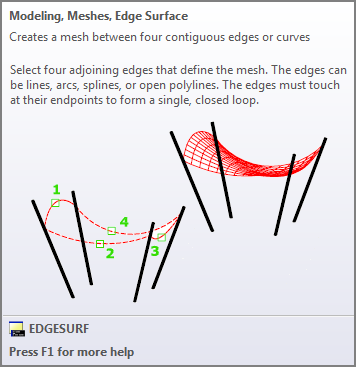
Figure 23-31: The Edge Surface cue card
Here’s how it works:
- On the Mesh tab’s Primitives panel, click the Modeling, Meshes, Edge Surface tool, or type Edgesurf↵.

- Select the four objects that are the edges of the surface you want to create. Make sure you select the objects in clockwise or counterclockwise order. Don’t select them “crosswise.”
Ruled Surface
The Ruled Mesh tool creates a surface mesh from two 2D objects such as lines, arcs, polylines, or splines. This is perhaps the simplest mesh tool to use since you have to click only two objects to form a mesh (see Figure 23-32). But like Edge Mesh, it has a tricky side. The location where you click will affect the way the mesh is generated. You’ll want to click the same side of each object unless you want the surface to twist, as shown in Figure 23-33.
To create a ruled mesh, follow these steps:
- On the Mesh tab’s Primitives panel, click the Modeling, Meshes, Ruled Surface tool, or type Rulesurf↵.

- Click two objects that are not on the same XY plane. The mesh is created between the objects.
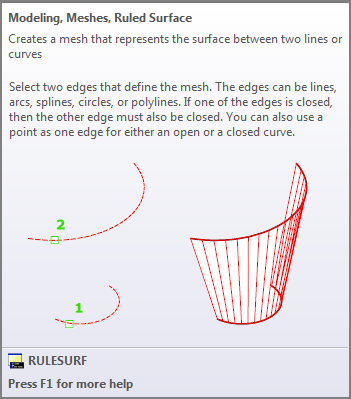
Figure 23-32: The Ruled Surface cue card

Figure 23-33: Where you click an object affects the outcome.
Tabulated Surface
The Tabulated Mesh tool is like an extrude tool for surfaces (see Figure 23-34). Chapter 20 showed you how you can use the Extrude tool to create a 3D solid from a closed polygon. The Extrude tool will also work on open polygons, lines, and arcs, but it will extrude the object in only a perpendicular direction. The Tabulated Surface tool lets you “extrude” an object in a direction you control with a line. The line can point in any direction in space.
Here’s how to use it:
- On the Mesh tab’s Primitives panel, click the Modeling, Meshes, Tabulated Surface tool in the Primitives panel, or enter Tabsurf↵.

- Select the object that defines the profile of your mesh.
- Click the object that defines the direction for the surface.
As with the other surface mesh tools, the point at which you select objects will affect the way the object is generated. For the tabulated mesh, the direction of the mesh depends on where you click the line that defines the surface direction.

Figure 23-34: The Tabulated Surface cue card
Converting Meshes to Solids
We mentioned earlier that you can convert a mesh to a solid. In doing so, you can take advantage of the many solid-editing tools available in AutoCAD. The Boolean tools can be especially useful in editing meshes that have been turned into solids.
Conversion is a fairly simple process using the tools in the Convert Mesh panel of the Mesh tab. Just click the Convert To Solid tool, or type Convtosolid↵, and then select the mesh or meshes you want to convert. Press ↵ to complete the process. The Convert To Surface tool (Convtosurface↵) works in much the same way, but it creates a surface object instead of a solid.
When you convert a mesh to a solid, you have the option to apply more or less smoothing to the conversion process. The Smoothed, Optimized flyout in the Convert Mesh panel gives you four options. You can select one of these options before you use the Convert To Solid or Convert To Surface tool to get a different smoothing effect during the conversion. Table 23-1 describes these options and how they affect the conversion of meshes.
Table 23-1: Options on the Convert Mesh panel’s flyout
| Option | Effect on mesh |
| Smoothed, Optimized | The mesh is smoothed and the faces are merged. |
| Smoothed, Not Optimized | The mesh is smoothed but maintains the same number of faces as the original. |
| Faceted, Optimized | The facets are maintained, and the smoothing remains the same but planar faces are merged. |
| Faceted, Not Optimized | The facets are maintained, the smoothing remains the same, and the number of faces also remains the same. |
Understanding 3D Surfaces
So far in this book you’ve worked with 3D solids and meshes. A third type of 3D object called a surface completes the AutoCAD set of 3D modeling tools to make it a complete 3D modeling application in its own right.
Click the Surface tab, and you’ll see the Surface panels that offer the tools you’ll need to work with surface modeling (see Figure 23-35).

Figure 23-35: The Surface tab and Ribbon panels
In the Create panel, you see a different set of tools from the Mesh and Solid tabs, but a handful should look familiar. The Loft, Sweep, Extrude, and Revolve tools at the far left of the Create panel are tools you’ve seen in previous chapters. These surface creation tools work in the same way as the tools of the same name in the Solid tab. In fact, they are essentially the same tools. They just use a different command option to create a surface instead of a solid. The big difference is that to create a solid, you need to start with a closed polyline. With the surface version of the Loft, Sweep, Extrude, and Revolve tools, you can start with an open spline, polyline, or other object. And even if you do use a closed object such as a circle or closed polyline, you will still get a 3D surface instead of a solid (see Figure 23-36).
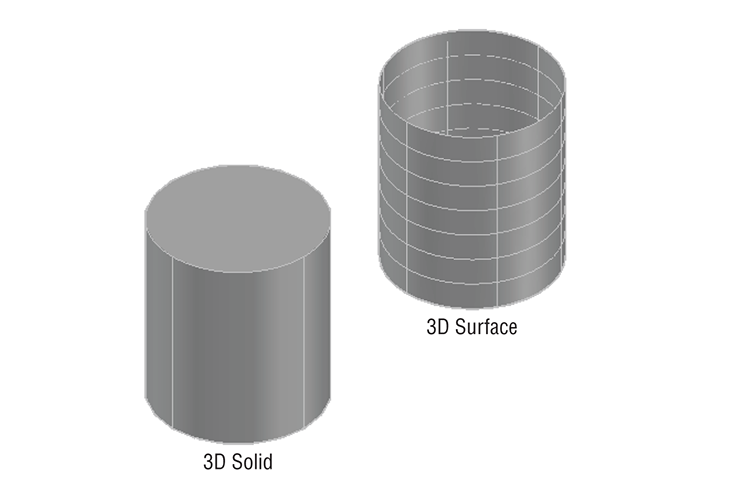
Figure 23-36: A circle extruded using the solid Extrude and the surface Extrude
Two other surface-creation tools that are unique to the Surface tab of the Ribbon are the Network Surface and Planar Surface tools. Here’s a brief description of each:
- Network Surface Tool The Network Surface tool lets you create a surface from several curves. The cue card for the Network Surface tool gives you a good idea of how this tool works (see Figure 23-37).

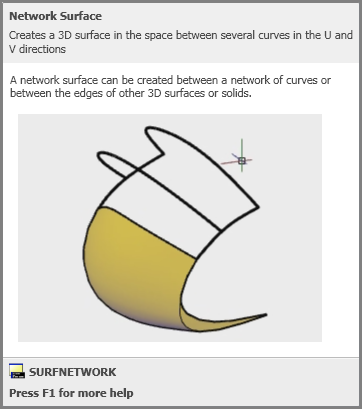
Figure 23-37: The cue card description of the Network Surface tool
- Planar Surface Tool The Planar Surface tool creates a flat surface either by selecting two points to indicate a rectangular surface or by selecting a closed 2D object to create a flat surface with an irregular boundary (see Figure 23-38).


Figure 23-38: Creating a planar surface
Editing Surfaces
Once created, surface objects have a unique set of editing tools that allow you to create fairly detailed models. Some tools, like Surface Fillet and Surface Trim, offer the same function as their 2D drawing counterparts. The following list includes a description of each tool:
- Surface Fillet With the Surface Fillet tool, you can join one surface to another with an intermediate rounded surface (see Figure 23-39).

Figure 23-39: Using the Surface Fillet and Surface Trim tools
- Surface Trim The Surface Trim tool lets you trim one or several surfaces to other surfaces.
- Surface Untrim Surface Untrim does exactly what it says. It reverses a trim operation.
- Surface Extend The Surface Extend tool simply enables you to extend the edge of a surface beyond its current location. Unlike its 2D equivalent, it does not extend a surface to another surface object, though you could extend beyond a surface and then use the Trim tool.
- Surface Sculpt The Surface Sculpt tool is like a super trim. You can align several surfaces to enclose a volume completely (the left image in Figure 23-40), and then use the Sculpt tool to trim all of the surfaces at once into a completely closed 3D shape (the right image in Figure 23-40). By default, the new object is a solid.

Figure 23-40: The Surface Sculpt tool creates a container-like shape from several surfaces.
The Create panel also offers three other tools that could be considered editing tools. Blend, Patch, and Offset need existing surfaces to do their job, so they may seem a bit like editing tools. Here’s a description of each:
- Surface Blend Surface Blend will connect two surfaces with an intermediate surface.
- Surface Patch The Surface Patch tool will close an open surface like the end of a tube. Surface Patch also lets you control whether the closing “patch” is flat or curved, as shown in Figure 23-41.
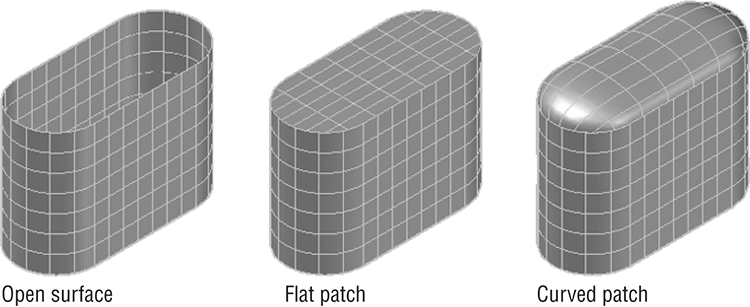
Figure 23-41: The Surface Patch tool can create a flat or rounded patch over an open surface.
- Surface Offset Surface Offset, like the Surface Trim tool, mimics its 2D counterpart. It will create a new surface that is parallel to the original. When you start the Surface Offset tool from the Create panel and select a surface, you’ll see arrows indicating the direction of the offset. You can type F↵ to flip the direction of the offset. Enter a distance for the offset, and press ↵ to create the offset surface (see Figure 23-42).
Using Extrude, Surface Trim, and Surface Fillet
Now that you have an overview of the basic surface modeling tools, try the following set of exercises to see how they work.

Figure 23-42: Using the Create panel’s Surface Offset tool
Using the Extrude Tool
Start with the Extrude tool on two basic shapes:
- Open the
Surfaces1.dwgfile from the sample folder. - Choose Extrude from the Surface tab’s Create panel.

- Click the circle in the drawing, and then press ↵. A surface appears and its length changes as you move the cursor.
- Adjust the surface height to 5 units so that it looks similar to Figure 23-43 on the left.
- Click Extrude again and extrude the arc horizontally 5 units while your cursor is left of the arc so that it looks similar to the extrusion on the right side of Figure 23-43.
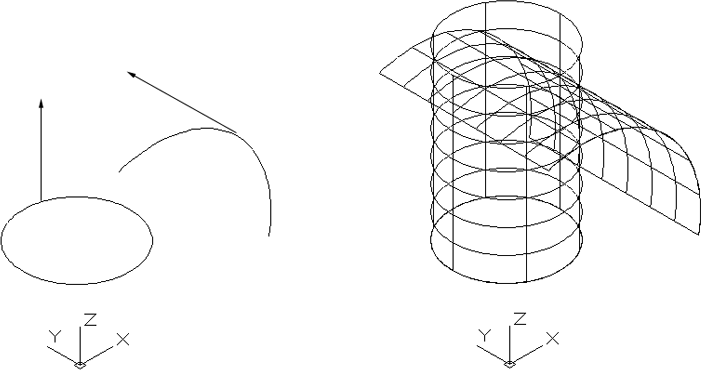
Figure 23-43: Extrude the circle and arc (left image) 5 units to look like the image on the right.
As you can see, the Extrude tool is similar to the Extrude tool in the Solid tab in how it works, but the objects created are surfaces.
Using the Surface Trim Tool
The Surface Trim tool is similar to the 2D Trim tool except that there is an additional step at the beginning, where you select the object you intend to trim. At first this step seems redundant, but after you use the tool for a while, it begins to make more sense. Also notice that the original arc you used to extrude the arc surface is still there. You’ll use that a little later in this chapter.
Next try out the Surface Trim tool:
- Click Surface Trim in the Surface tab’s Edit panel.

- Click both the cylinder and the extruded arc surface, and then press ↵. This first step selects the objects to trim.
- Click both objects again, and then press ↵. This time you’re selecting the objects to trim to. You want to trim the top of the cylinder to the arc and the arc to the cylinder.
- Finally, click the cylinder near the top edge to indicate what part you want to trim. Also click the extruded arc surface anywhere outside of the cylinder. Press ↵ to end the command. Your surfaces should look like the right-side image in Figure 23-44.

Figure 23-44: Trimming the surfaces
Using the Surface Fillet Tool
Now try out the Surface Fillet tool:
- Click the Surface Fillet tool in the Surface tab’s Edit panel.

- Click the top surface, and then click the cylinder. The two surfaces are “filleted,” as shown in Figure 23-45.
- The following prompt appears:
Press Enter to accept the fillet surface or [Radius/Trim surfaces]. Type R↵ to enter a different radius. - Type 0.5↵. The radius changes. You still have the opportunity to change the radius again.
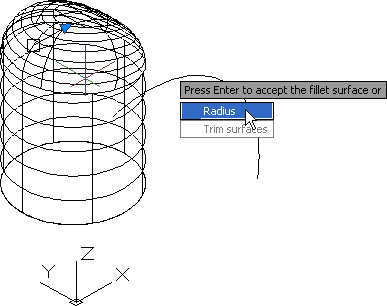
Figure 23-45: Using the Surface Fillet tool
- Type R↵, and then type 0.2↵. The radius changes again.
- Press ↵ to finish the fillet.
In this case we created a fillet all of the way around the top of the cylinder. While you’re creating surface fillets, you’ll see a preview of what the new surface will look like. You don’t have to stick with that fillet until you fully finish the command; you are free to make changes to the fillet until then.
Using Surface Blend, Patch, and Offset
As mentioned earlier, a few of the tools on the Create panel are a bit like editing tools. Surface Blend, Surface Patch, and Surface Offset create new surfaces that use existing surfaces as their basis. Surface Blend is a bit like the Surface Fillet tool in that it will join two surfaces with an intermediate surface. Surface Offset creates a new surface that is parallel to an existing one and is similar to the 2D offset command. Surface Patch will create a surface that closes an open-ended surface.
To get a better idea of how these three tools work, try the following set of exercises. Start by creating a parallel copy of an existing surface using the Offset tool:
- Open the
Patch1.dwgsample file from theChapter 23sample folder. - Click the Surface Offset tool from the Surface tab’s Create panel.

- Click the surface in the drawing, and then press ↵. You see a set of arrows appear as shown in the left image of Figure 23-46.
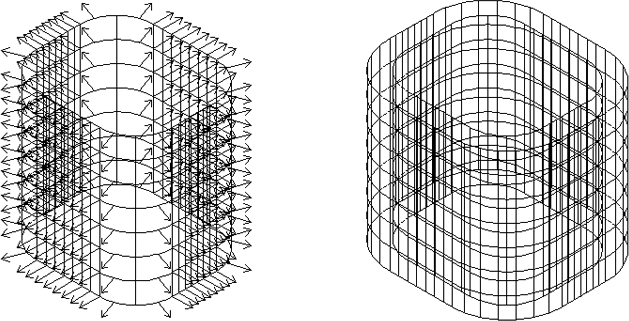
Figure 23-46: Using the Surface Offset tool
- Type F↵. The arrows now point in the opposite direction.
- Type F↵ again to return the arrows to their previous direction facing outward.
- Enter 0.5↵ for the offset distance. The offset surface appears around the original surface, as shown on the right in Figure 23-46.
Here you see how the Surface Offset tool differs from the 2D Offset tool that you’ve seen in Chapter 18, “Drawing Curves.” The arrows play an important role in helping you visualize the result of your offset, so instead of picking a direction, you adjust the direction of the arrows.
Using the Surface Blend Tool
Now try the Surface Blend tool:
- Use the Move command to move the outer surface vertically in the z-axis roughly 5 units. Remember that you can hold down the Shift key to restrain the cursor to the z-axis. If you see the Surface Associativity message, click Continue. You’ll learn more about associativity later in this chapter.
- Adjust your view so that you can see both surfaces, and then click the Surface Blend tool in the Surface tab’s Create panel.

- Select the eight edges along the top of the lower surface, as shown in Figure 23-47. When you’re sure you’ve selected all of the edges, press ↵. You can also select the Chain option, which will find all edges that are connected.
- Select the eight edges along the bottom of the upper surface, as shown in Figure 23-47. When you’re sure you’ve selected all of the edges, press ↵. A new, preview surface appears that joins the upper and lower surfaces.
- You might notice a couple of grip arrowheads that appear along the top and bottom edge of the new blend surface. Click one of them, and a menu appears offering three options: Position, Tangent, and Curvature (see Figure 23-48).

Figure 23-47: Selecting the edges for the Surface Blend tool

Figure 23-48: Using the grip arrowhead to adjust the blend surface
- Click Curvature, and then press ↵ to place the blend surface.
The Surface Blend tool offers a number of options that control the shape of the blend surface. You saw three options available from the grip arrowhead. The options are available even after you have placed the surface. You can click on the surface to expose the grip arrowheads.
In addition, the Surface Blend tool offers two command options: CONtinuity and Bulge Magnitude. Table 23-2 in the next section describes these features and their functions.
Using the Surface Patch Tool
Now let’s take a look at the Surface Patch tool. This tool lets you close the end of a surface with another surface. You can add a flat or curved surface, as you’ll see in the next exercise.
Try adding a patch surface to the top of the upper surface in the Patch1.dwg model:
- Pan your view so that you can clearly see the top of the surface model, as shown in the left image in Figure 23-49.
- Click the Surface Patch tool in the Surface tab’s Create panel.
- Select the edges of the surface, as shown in Figure 23-49.
- Press ↵ when you are sure you’ve selected all of the edges. The patch surface appears.
- Click the grip arrowhead that appears along the edge of the patch and select Tangent. The surface is now curved.
- Press ↵ to finish the patch surface.
- To get a better view of the surface, select the Shaded With Edges option from the Visual Styles drop-down list in the View tab’s Visual Styles panel. Your model should resemble the right side of Figure 23-49.

Figure 23-49: Adding the patch surface to the end of the model
You may have noticed that the grip arrowhead options in step 5 were similar to the grip options you saw for the Surface Blend tool. The Surface Patch tool offers an additional command option called CONStrain Geometry. Table 23-2 describes these options.
Table 23-2: The Blend and Patch options
| Feature option | Function |
| Position (G0) | Causes the surface to connect without any blending curvature. |
| Tangent (G1) | Causes the surface to blend with direction. |
| Curvature (G2) | Causes the surface to blend with direction and similar curvature or similar rate of change in the surface direction. |
| Command option | Function |
| CONtinuity | Controls how smoothly the surfaces flow into each other. |
| Bulge Magnitude | Allows you to adjust the amount of bulge or curvature in the blend surface. Values can be between 0 and 1. |
| CONStrain Geometry (Surfpatch command) | Offers additional guide curves to control the patch surface. |
Understanding Associativity
You may have noticed the Surface Associativity icon in the Create panel. This is feature is on by default, and its function is similar to the Associative feature of hatches (see Chapter 7, “Mastering Viewing Tools, Hatches, and External References,” for more on hatches). You may recall that when you create a 2D hatch pattern with the hatch associative feature turned on, the hatch’s shape will conform to any changes made to the boundary used to enclose the hatch pattern.
The Associativity feature in surface modeling works in a similar way, only instead of a hatch pattern conforming to changes in a boundary, the surface conforms to changes in the shapes that are used to create them. For example, if you were to make changes to the arc that you used to extrude the arc surface, the arc surface and the trimmed cylinder would also follow the changes.
Using Associativity to Edit a Surface Model
This concept is a bit tricky to explain. Try the following exercise to see how associativity works firsthand:
- Return to the
Surfaces1.dwgfile, and click the arc to expose its grips. - Click the square grip at the arc’s left endpoint and drag it downward along the z-axis. When it is roughly in the position shown in Figure 23-50, click again to fix the grip’s location. The shape of the surface model changes to conform to the new shape of the arc.
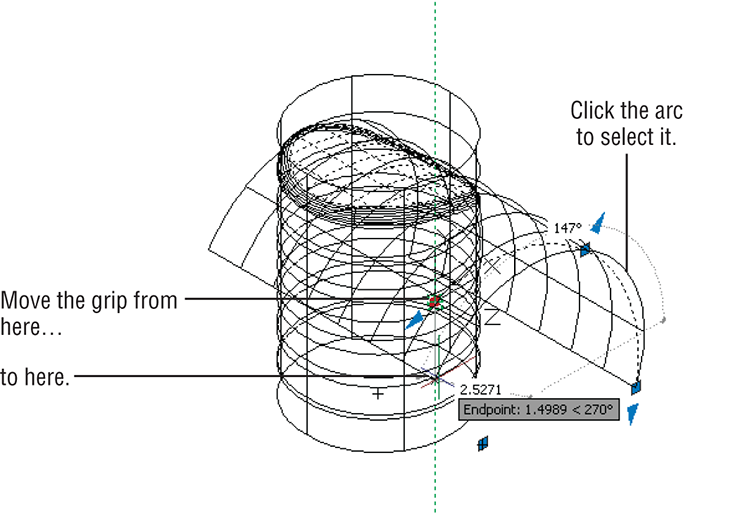
Figure 23-50: Adjusting the shape of the arc
- Zoom into the top of the surface model so that you have a view similar to Figure 23-51.
- Click the filleted portion of the surface. An arrowhead grip appears.
- Click the arrowhead grip. Another arrowhead grip appears.
- Click this arrowhead grip, and slowly drag it toward the center of the cylinder. Notice that the radius of the fillet changes as you move the grip.
- Click to fix the fillet radius to its new size.
- Press the Esc key to clear your selection.

Figure 23-51: Adjusting the fillet radius
Using Arrowhead Grips to Edit a Surface
You’ve just seen the Associativity feature in action. You can also change the shape of the circle used to extrude the cylinder to modify the surface model’s diameter. Additional hidden grips are available that allow you to adjust the shape of the surfaces directly. For example, you can modify the taper of the cylinder using an arrowhead grip that you can turn on using the Properties palette, as shown in these steps:
- Click the cylindrical part of the surface model.
- Right-click and select Properties.
- Scroll down to the bottom of the Properties palette to the Surface Associativity panel.
- Click the Show Associativity option, and select Yes.
- Close the Properties palette.
- At the top of the cylinder, click and drag the right-pointing arrowhead grip to the right. As you do this, you see the dynamic display showing you an angle (see the image on the left in Figure 23-52).
- Position the arrowhead grip so that the angle shows 6, and then click to fix the grip in place. The cylinder is now tapered and the top surface conforms to the new shape, as shown in the image on the right in Figure 23-52.
Surface Associativity can be very useful, but in order to take full advantage of this feature, you will want to plan your model construction carefully. In addition, the Associativity feature can limit some editing and creation functions. For example, the Surface Fillet tool may not work on a complex surface model with associativity turned on but will work when the associativity is turned off for the objects involved.
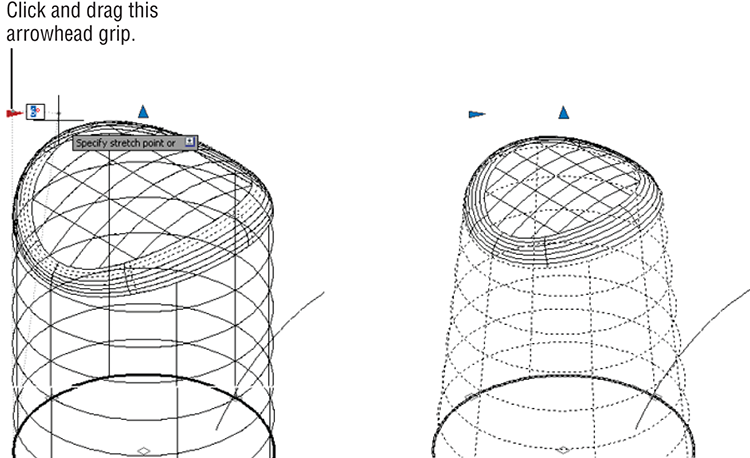
Figure 23-52: Changing the taper of the cylinder
Turning Off or Removing Associativity
You can turn off or remove associativity for an object through the Properties palette. Select the object, and then right-click and select Properties. In the Properties palette, scroll down the palette to the Surface Associativity group (see Figure 23-53). This group offers two options: Maintain associativity and Show associativity. The Maintain associativity option offers Yes, Remove, and None.

Figure 23-53: The Surface Associativity group in the Properties palette
You can select Remove to remove associativity altogether or None to limit the associativity to the set of objects currently associated with the surface model. After you change this setting, you can’t return to a previous setting except with the Undo command.
Editing with Control Vertices
So far you’ve been creating what are called procedural surfaces, which are surfaces that allow you to take advantage of associativity. AutoCAD also allows you to create NURBS surfaces. You may recall that splines are also NURBS, so you might think of a NURBS surface as a kind of 3D surface spline. Splines allow you to move, add, or subtract control vertices (CVs), and you can control the way the CVs “pull” on the curve of the spline. Likewise, NURBS surfaces allow you to add or remove CVs and adjust the direction and force of the CVs.
There are two ways to create a NURBS surface. You can turn on the NURBS Creation option in the Surface tab’s Create panel and then go about creating your 3D surfaces. Any 3D surface you create with this option turned on will be a NURBS surface. Or you can convert an existing surface to a NURBS surface.
Converting a Surface to a NURBS Surface

You can convert an existing surface to a NURBS surface by using the Convert To NURBS tool on the Surface tab’s Control Vertices panel. This tool also converts 3D solids and meshes. To use it, follow these steps:
- Open the
CVedit1.dwgsample file. - Turn off Surface Associativity in the Surface tab’s Create panel.

- Turn on NURBS Creation in the Surface tab’s Create panel.

- Click the Extrude tool in the Surface tab’s Create panel.

- Click the spline and press ↵.
- Point the cursor upward, and type 6↵ to make the extruded surface 6 units in the z-axis.
If you want to create NURBS objects, be sure to turn on NURBS Creation. It’s easier to create objects as NURBS than to have to go through the extra step of converting them later.
Exposing CVs to Edit a NURBS Surface
You’ve just created a NURBS surface. You can expose the CVs for the surface using the Show CV tool. Try the following to view and edit the CVs:
- Click the Surface CV – Show tool in the Control Vertices panel.

- Click the surface you just created and press ↵. The CVs appear for the surface.
- Click the surface to select it, and then click the CV, as shown in Figure 23-54.
- Move the CV in the y-axis, and notice how the surface deforms. The top edge moves with the CV, whereas the bottom edge maintains its shape.
- Press the Esc key twice to clear your selection.
In this exercise, you saw how you can gain access to the CVs of a NURBS surface to make changes to the shape. Right now, the CVs are located only at the top and bottom of the surface, but you can add more CVs to give you more control over the shape of the surface.
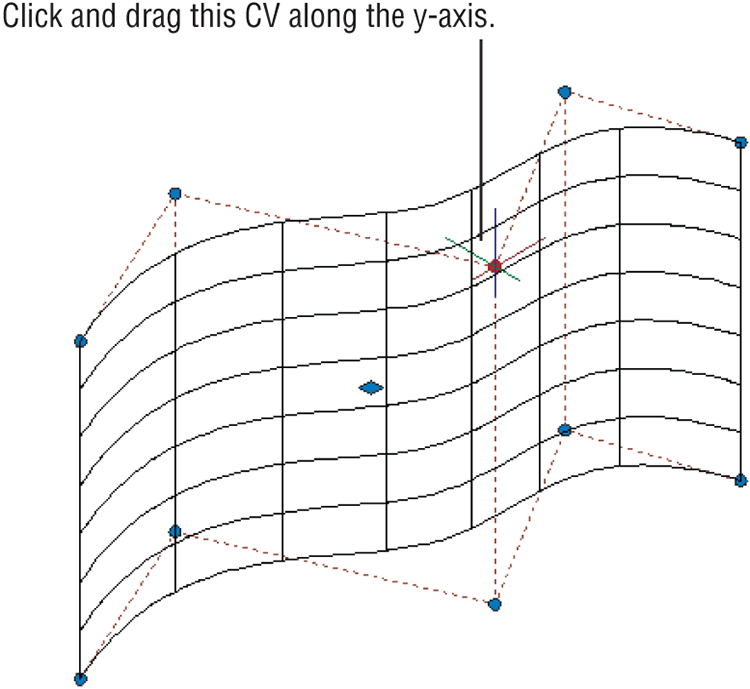
Figure 23-54: Exposing the CVs
Adding CVs to a NURBS Surface
The next exercise shows you how you can add additional CVs through the Rebuild option:
- Click the Surface – Rebuild tool in the Control Vertices panel, and then click the surface. Or you can click the surface to select it and then right-click and select NURBS Editing ⇒ Rebuild. The Rebuild Surface dialog box appears (see Figure 23-55).

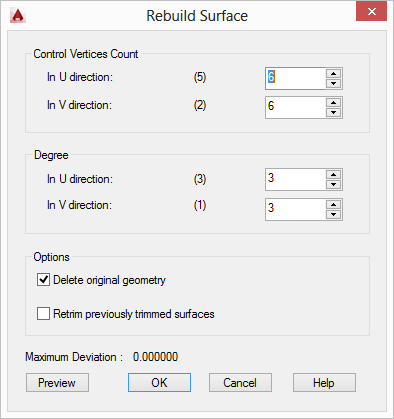
Figure 23-55: The Rebuild Surface dialog box
- In the Control Vertices Count group of the Rebuild Surface dialog box, make sure the In U Direction option is set to 8 and the In V Direction option is set to 7. You’ll see what these settings do in a moment.
- Click OK. Now you see that many more CVs are available.
In step 2 you specified the number of CVs you want in the U and V directions. The U direction is along the horizontal curve, and the V direction is along the straight, vertical direction. If you count the CVs in each row or column, you’ll see that they match the values you entered in step 2.
Now if you were to move a CV, the surface is able to deform along the z-axis, whereas it remained a straight line before.
The Rebuild Surface dialog box offers a number of other options you’ll want to know about. Table 23-3 gives you a rundown.
Table 23-3: The Rebuild Surface dialog box
| Section/option | Effect |
| Control Vertices Count | |
| Sets the number of CVs in the U direction | In U Direction |
| Sets the number of CVs in the V direction | In V Direction |
| Degree | |
| In U Direction | Sets the number of CVs available per span in the U direction |
| In V Direction | Sets the number of CVs available per span in the V direction |
| Options | |
| Determines whether the original geometry is retained | Delete Original Geometry |
| Determines whether trimmed surfaces are retained from the original surface | Retrim Previously Trimmed Surfaces |
| Displays the maximum deviation between the original and rebuilt surface | Maximum Deviation |
Two other tools just below the Surface Rebuild tool allow you to either add or remove a set of CVs. The Surface CV – Add tool lets you place a row of CVs. The Surface CV – Remove tool will remove a row of CVs. Both options allow you to toggle between the U and V directions for the row addition or removal by typing D↵.
The Surface CV Add and Remove tools can be useful when you want to fine-tune the curvature of a surface. Where you want a “tighter” curve, you can add more CVs to an area of the surface. You can then move the CVs in the selected area to increase the curvature. To smooth out the curvature of an area, remove the CVs.
Editing with the CV Edit Bar
You’ve seen how a NURBS surface can be set up to add additional CVs, which in turn allow you to adjust the shape of the surface. But the CVs by themselves allow you to adjust their pull on the surface only by moving them closer or farther away from the surface.
The CV Edit bar gives you more control over the behavior of individual CVs. With the CV Edit bar, you can change the strength and direction of the “pull” exerted by a CV.
Try the following exercise to see how the CV Edit bar works:
- Click the Surface CV Edit Bar tool in the Control Vertices panel.

- Select the surface. Now as you move the cursor across the surface, you see two red lines that follow the U and V directions of the surface (see Figure 23-56).
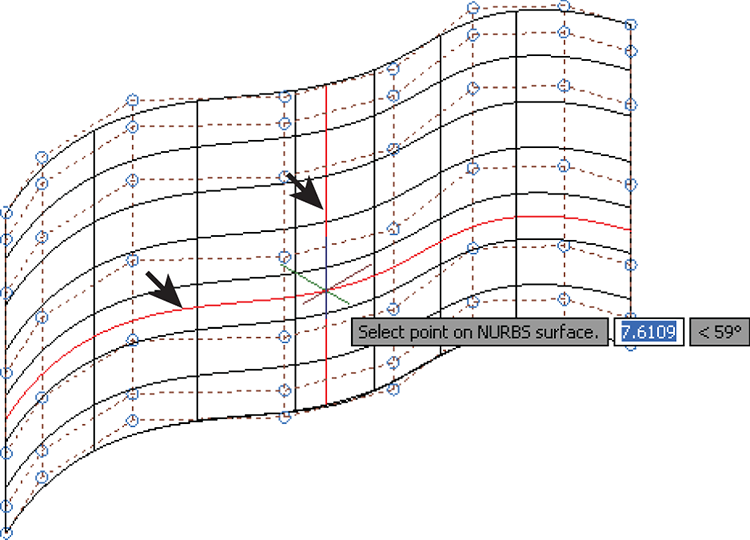
Figure 23-56: The CV Edit bar’s U and V directions are shown by two red lines.
- Click the point shown in Figure 23-56. A Move gizmo appears along with two other features called the magnitude handle and the expansion grip (see Figure 23-57).
The Move gizmo gives you a bit more control over the location of the CV since it allows you to isolate movement in the X, Y, or Z direction. The expansion grip lets you change the tangency of the CV, whereas the magnitude grip lets you control the strength of the CV.
Try the following steps to see how these two features work:
- Click the expansion grip and select the Tangent Direction option. Notice that the Move gizmo switches to the location of the expansion grip.
- Hover over the green y-axis of the gizmo, and when you see the green y-axis vector, click and drag the mouse. Notice how the surface warps as you move the mouse. If you look carefully at the CV Edit bar, you see that it pivots around the new location of the expansion grip, the CV location.
- Press the Esc key to release the y-axis, and then click the expansion grip and choose the Move Point option. The Move gizmo returns to its original location at the CV.
- Now click the magnitude handle, and move it horizontally. You see that the surface is “pulled” in both directions of the U direction of the surface.
- Press the Esc key to release the magnitude handle.
- Right-click the CV Edit bar and select V Tangent Direction. Notice that the magnitude handle changes its orientation so that it is aligned to the V direction of the surface.
- Click and drag the magnitude handle to see how it affects the surface.
- Press the Esc key twice to exit the CV Edit bar.
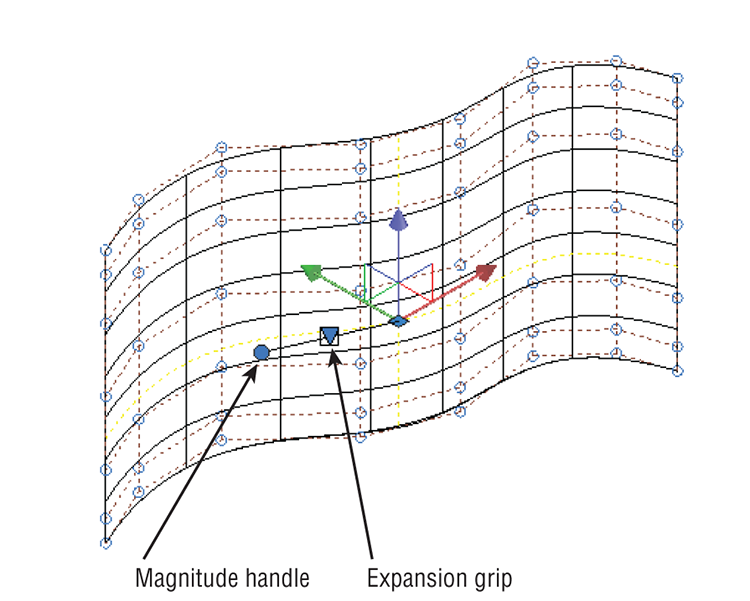
Figure 23-57: The magnitude handle and expansion grips.
As you can see from this exercise, the CV Edit bar gives you much more control over a CV than you would have otherwise. You also saw the context menu for the CV Edit bar in step 6 (see Figure 23-58). The context menu allows you to change the direction of the magnitude grip, but it also lets you switch the position of the Move gizmo and the expansion grip with the Move Point Location and Move Tangent Direction options. The Relocate option lets you move to a different CV location. Table 23-4 includes descriptions of these options.
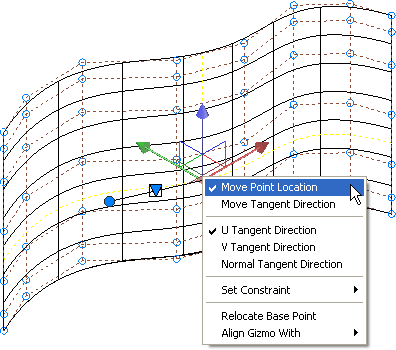
Figure 23-58: The CV Edit bar’s context menu
Table 23-4: The CV Edit bar’s right-click options
| Option | Purpose |
| Move Point Location | Places the Move gizmo at the CV location |
| Move Tangent Direction | Places the Move gizmo at the expansion grip location to allow adjustment to the tangent direction of the CV |
| U Tangent Direction | Aligns the magnitude grip to the surface’s U direction |
| V Tangent Direction | Aligns the magnitude grip to the surface’s V direction |
| Normal Tangent Direction | Aligns the magnitude grip to a direction that is normal (perpendicular) to the surface |
| Set Constraint | Constrains changes to the tangency in a specific direction such as X, Y, or Z or in a plane defined by a pair of axes |
| Relocate Base Point | Moves the CV Edit bar to a different location on the surface |
| Align Gizmo With | Aligns the gizmo with the world or current UCS or with a face on the surface |
Making Holes in a Surface with the Project Geometry Panel
Eventually, you’ll need to place an opening in a surface, so AutoCAD offers the Project Geometry panel. This panel contains several tools that allow you to project a closed 2D object’s shape onto a 3D surface. For example, if you want to place a circular hole in the surface you edited in the previous exercise, you would draw a circle parallel to that surface and then use the Surface Projection UCS tool.
Try the following exercise to see how the Project Geometry feature works:
- Select the Layer Properties tool from the Layers panel of the Home tab.
- Turn on the Circle layer. A circle appears in the drawing.
- Type UCS↵, and then type OB↵. This lets you align the UCS to an object.
- Click the circle to align the UCS to it.
- In the Surface tab’s Project Geometry panel, click the Surface Auto Trim tool to turn it on.

- Click the Surface Projection UCS tool in the Project Geometry panel.
- Click the circle and press ↵.
- Click the surface. The circle is projected onto the surface and the area inside the projected circle is trimmed (see Figure 23-59).
In this exercise, you aligned the UCS to the circle. The Surface Projection UCS tool you used in step 6 projected the circle in the z-axis of this new UCS that is aligned with the circle.
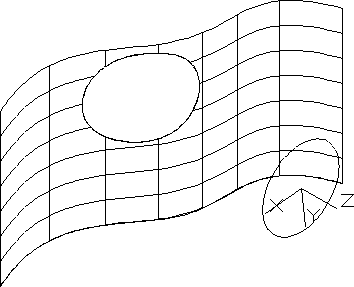
Figure 23-59: The circle projected onto the surface
The other two Project Geometry tools use different criteria to project geometry. The Surface Projection View projects geometry along the line of sight. If you had used this tool in the previous exercise, the projected circle and opening would appear directly behind the circle in your current view. The Surface Projection Vector projects geometry along a vector that you indicate with two points. You can use the 3D object snaps to select points on the geometry and the surface.
Visualizing Curvature: Understanding the Analysis Panel
In addition to the surface editing tools, AutoCAD offers several surface analysis options. These options offer some visual aids to help you see the curvature of your surface models more clearly. They can be found in the Analysis panel of the Surface tab and are called Analysis Zebra, Analysis Curvature, and Analysis Draft.
Analysis Zebra displays stripes that let you better visualize how the curvatures of surfaces blend (see Figure 23-60). The smoother the stripes, the better the transition between surfaces.
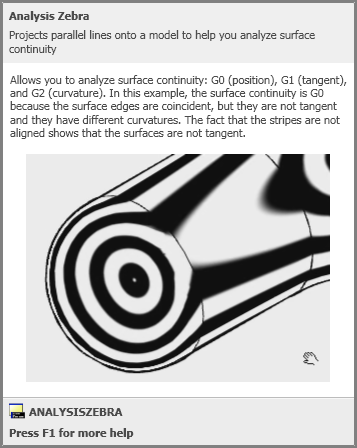
Figure 23-60: The cue card description for Analysis Zebra
Analysis Curvature displays colors to indicate the direction and amount of curvature in a surface (see Figure 23-61). As the cue card describes, a negative curvature is a saddle shape and displays a blue color. A positive curvature, or bowl shape, displays in red.
Analysis Draft displays colors to help you determine draft angles (see Figure 23-62). Draft angles are often used in the design of objects that are to be cast from a mold, and they are important in allowing the cast object to be removed easily from the mold.
The Analysis Options tool opens the Analysis Options dialog box, where you can control the way the different analysis tools are displayed. Note that graphics hardware acceleration must be turned on before you can use these tools. You must also use a visual style other than Wireframe.
To turn on graphics hardware acceleration, right-click the Hardware Acceleration tool in the right portion of the status bar and select Hardware Acceleration.
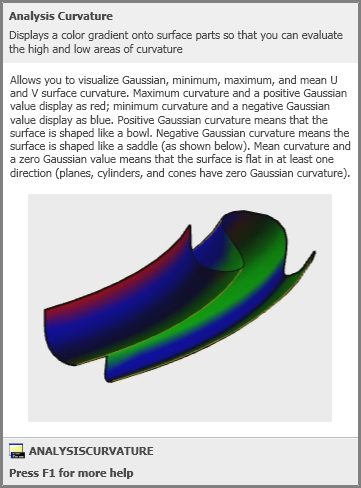
Figure 23-61: The cue card description for Analysis Curvature

Figure 23-62: The cue card description for Analysis Draft
The Bottom Line
- Create a simple 3D mesh. Mesh modeling allows you to create more organic 3D forms by giving you unique smoothing and editing tools. You can start your mesh model by creating a basic shape using the mesh primitives.
- Master It Name the seven mesh primitives available on the Primitives panel of the Mesh Modeling tab.
- Edit faces and edges. The ability to edit faces and edges is essential to creating complex shapes with mesh objects.
- Master It Name the tool that is used to divide a face into multiple faces.
- Create mesh surfaces. The Mesh primitives let you create shapes that enclose a volume. If you just want to model a smooth, curved surface in 3D, you might find the surface mesh tools helpful.
- Master It How many objects are needed to use the Edge Surface tool?
- Convert meshes to solids. You can convert a mesh into a 3D solid to take advantage of many of the solid-editing tools available.
- Master It Name at least two tools you can use on a solid that you cannot use on a mesh.
- Understand 3D surfaces. 3D surfaces can be created using some of the same tools you use to create 3D solids.
- Master It Name at least two tools you can use to create both 3D solids and 3D surfaces.
- Edit 3D surfaces. AutoCAD offers a wide range of tools that are unique to 3D surfaces.
- Master It Name at least four tools devoted to CV editing.
